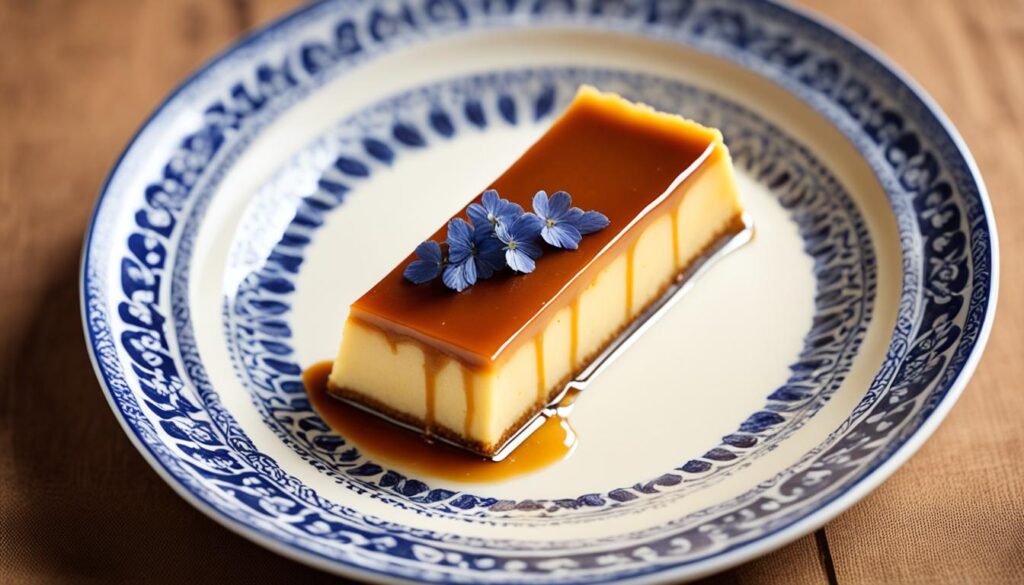Flan is a classic dessert that has variations in different cultures, including Filipino and Mexican cuisine. While both Filipino flan and Mexican flan share some similarities, there are also distinct differences in their recipes, ingredients, taste, and cultural significance. In this article, we will delve into the details of these two flan variations and explore how they differ from each other.
Key Takeaways:
- Filipino flan and Mexican flan are variations of the classic dessert, flan.
- Although they share some similarities, there are distinct differences in their recipes, ingredients, taste, and cultural significance.
- Filipino flan is known as crème caramel and is made with eggs, sweetened condensed milk, evaporated milk, vanilla, and sugar.
- Mexican flan, also known as caramel custard, includes eggs, sweetened condensed milk, evaporated milk, and vanilla, with a caramel sauce.
- Flan holds cultural significance in both Filipino and Mexican traditions and is enjoyed during celebrations and family gatherings.
What is Flan?
Flan is a traditional dessert that has gained popularity in various parts of the world, including Latin America, Mexico, and the Philippines. Originating in Spain, flan is a creamy custard dessert known for its delightful combination of flavors and textures. It consists of a smooth and velvety custard base that is typically made with eggs, milk, and sugar. The custard is then baked or steamed to achieve the desired consistency. One of the distinguishing features of flan is its caramelized sugar glaze on top, which adds a sweet and slightly bitter taste that perfectly complements the creamy custard.
Flan is often referred to as “crème caramel” in the Philippines, highlighting its popularity and presence in Filipino cuisine. It is cherished as a traditional dessert that has become a part of cultural celebrations and family gatherings. In Latin American and Mexican cultures, flan holds a special place on the dessert menu, appreciated for its rich and indulgent nature.
Filipino Flan: Recipe and Flavor Profile
Filipino flan, also known as crème caramel, is a delightful dessert made with a simple yet delicious combination of ingredients. The recipe typically includes eggs, sweetened condensed milk, evaporated milk, vanilla, and sugar. These ingredients come together to create a creamy and decadent custard that is sweet and indulgent.
To make Filipino flan, the ingredients are blended together until smooth and then baked in the oven. The baking process allows the custard to set and develop its luscious texture. Once cooked, the flan is refrigerated to chill and set further, enhancing its smoothness and richness.
One of the key characteristics of Filipino flan is its silky smooth texture. The custard is velvety and melts in your mouth, creating a luxurious sensation with every bite. The combination of eggs and milk gives the flan its creamy consistency, making it a truly satisfying dessert.
In terms of flavor, Filipino flan offers a delightful balance of sweetness and depth. The caramelization of sugar creates a rich and slightly bitter caramel sauce that adds a wonderful complexity to the dessert. The sweetened condensed milk and vanilla infuse the custard with a subtle but distinct flavor, enhancing the overall taste experience.

Filipino flan is commonly served chilled, making it a refreshing treat on a warm day or after a hearty meal. Its creamy texture and sweet flavor make it a favorite among dessert lovers, and it is often enjoyed on special occasions or as a simple indulgence.
Next, we will explore Mexican flan, another delicious variation of this beloved dessert.
Mexican Flan: Recipe and Flavor Profile
Mexican flan, also known as caramel custard, is a delicious dessert with a unique recipe that sets it apart from Filipino flan. Made with eggs, sweetened condensed milk, evaporated milk, and vanilla, Mexican flan offers a creamy and smooth texture that is incredibly satisfying to the palate. To enhance its flavor, a caramel sauce is prepared by melting sugar and water together, which is then poured into the baking dish before adding the custard mixture. The result is a luscious dessert with a slightly smoky and sweet flavor profile.
One of the distinguishing features of Mexican flan is the caramelized sugar topping that adds an irresistible crunch and richness to each bite. This caramelization process imbues the flan with a deep, caramel flavor that complements the creamy custard perfectly. The combination of the smooth custard and the caramel topping creates a harmonious balance of textures and flavors that make Mexican flan a beloved dessert.
The cooking process for Mexican flan involves baking the custard in the oven in a water bath, which helps to ensure even and gentle cooking. This technique contributes to the creamy texture and prevents the flan from becoming too dry or rubbery. The end result is a velvety dessert that melts in your mouth with each spoonful.
Whether served at a festive celebration or enjoyed as a sweet treat on a regular day, Mexican flan never fails to impress with its delectable taste and enticing presentation. Its creamy texture, caramelized sugar topping, and rich flavor profile make it a dessert that is loved and cherished in Mexican cuisine.
Cultural Significance of Flan
Flan holds immense cultural significance in both Filipino and Mexican traditions. In the Philippines, flan is not just a dessert; it is a symbol of celebration and togetherness. This traditional dessert is often served during special occasions, such as birthdays, weddings, and holidays, bringing families and communities together in joyous gatherings. The Filipino culture deeply values the connection and unity fostered through sharing a delicious flan.
Similarly, in Mexican culture, flan is an integral part of their culinary heritage and is associated with various celebrations and festivities. For example, during the iconic Day of the Dead, or “Dia de los Muertos,” flan is a staple dessert that is shared among loved ones as an offering to departed souls. It represents the honoring of ancestors and the continuation of cultural traditions.
The cultural significance of flan extends beyond its role as a traditional dessert. It embodies the rich tapestry of history, family, and community that defines the essence of Filipino and Mexican cultures. Just as these cultures have a deep-rooted respect for their traditions and values, flan serves as a delicious symbol of their unique identities.
Flan’s presence in the culinary traditions of both cultures showcases the importance of family, celebrations, and the joy of coming together. Whether it’s a Filipino gathering or a Mexican fiesta, the shared love for flan reinforces the cultural bonds and represents the cherished moments spent with loved ones.
Conclusion: Appreciating the Unique Flavors
Filipino flan and Mexican flan may share some similarities, but they also have unique flavors that reflect the cultural diversity of these two countries. Both desserts are loved and appreciated in their respective cultures for their creamy textures and rich flavors. Whether you prefer the silky smoothness of Filipino flan or the caramelized sweetness of Mexican flan, both variations offer a delightful taste experience that showcases the culinary traditions and heritage of their respective cultures.
These desserts are not just about the sweetness but also about the cultural significance they hold. They go beyond being mere treats; they connect people to their roots, celebrating the flavors and memories passed down through generations. Filipino flan represents the essence of Filipino culture, with its creamy decadence giving a sense of comfort and nostalgia. On the other hand, Mexican flan captures the vibrancy of Mexican culture, with its lusciousness and caramelized notes reminiscent of fiestas and joyous gatherings.
So, the next time you indulge in a flan, take a moment to appreciate the unique flavors and the stories they tell. Allow yourself to be immersed in the cultural diversity that these desserts represent. Whether you find yourself savoring the Filipino flan or relishing the Mexican flan, let your taste buds be transported to the rich culinary traditions of these beautiful cultures. Desserts have a way of bringing people together, and Filipino flan and Mexican flan are no exception. With each spoonful, appreciate the artistry, history, and love that goes into creating these beloved desserts.
FAQ
What is the difference between Filipino flan and Mexican flan?
Filipino flan and Mexican flan have slight variations in their recipes, ingredients, taste, and cultural significance.
What are the ingredients used in Filipino flan?
Filipino flan is made with eggs, sweetened condensed milk, evaporated milk, vanilla, and sugar.
What are the ingredients used in Mexican flan?
Mexican flan is made with eggs, sweetened condensed milk, evaporated milk, and vanilla, but also includes a caramel sauce made from melted sugar and water.
How is Filipino flan cooked?
Filipino flan is prepared by blending the ingredients together and baking it in the oven.
How is Mexican flan cooked?
Mexican flan involves making a caramel sauce by melting sugar and water together, which is then poured into the baking dish before adding the custard mixture.
What is the texture of Filipino flan?
Filipino flan has a silky smooth texture.
What is the texture of Mexican flan?
Mexican flan has a creamy and smooth texture.
What is the flavor profile of Filipino flan?
Filipino flan has a rich and creamy flavor with a hint of vanilla.
What is the flavor profile of Mexican flan?
Mexican flan has a slightly smoky and sweet flavor due to the caramelized sugar topping.
How does flan hold cultural significance?
Flan is a popular dessert in both Filipino and Mexican cultures, often served during celebrations and family gatherings, representing tradition and togetherness.







